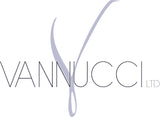How to clean and prolong the life of your handmade sterling silver and gold filled jewelry
One of the most common questions I get is about the care of jewelry, from Vannucci ltd and otherwise. I realized that I hadn't been highlighting this topic enough, and that's not fair! True care of your pieces can make them last a lifetime and beyond, and I want them to be lasting treasures for you.
STERLING SILVER

Let's start with sterling silver. Sterling silver means that the silver has been mixed with other metals, usually copper, but that the alloy is always 92.5% silver. This is done for strength - jewelry made from fine silver would break waaaaay too easily. That gray to black tone that the silver gets is a natural reaction, it's simply tarnish from the chemical reaction between the metal and oxygen.
To PREVENT this reaction:
- Wear it! One of the best ways to keep jewelry from tarnishing is by wearing it!! The oils on our skin coat the jewelry and slow tarnishing
- Store it right. Keep your jewelry in sealed baggies. Throw in a silica pack if you have one laying around!
- No dressing up for chores. Remove all jewelry before starting in with the scrubbing. Perfumes and sunscreens can also affect the metal.
- Be a hydrophobe. Don't leave your jewelry on the bathroom sink. In fact, don't store it in the bathroom at all, even in those ziplock baggies. Take it off when you're swimming, showering, or scuba diving with blacktip reef sharks in the Caribbean.
 Sometimes, though, we aren't thinking about our jewelry when we jump into the shower after a run, but there are remedies!
Sometimes, though, we aren't thinking about our jewelry when we jump into the shower after a run, but there are remedies!
To RECTIFY this reaction:
- Soap and Water. Start with this very mild method. Try to use something without a lot of extras like perfumes. I use a toothbush and gently scrub the metal in swirls, trying my best to avoid the gemstones, especially opals and pearls. Those two are particularly sensitive to water.
- Baking soda and water. With this method, you want to mix the baking soda and water to create the right consistency for the jewelry. If there are a lot of stones, or if it's a pretty solid stretch of metal, you want it to be more of a paste that you deposit right where you want it. For jewelry with etching or no gemstones, you can make more of a slurry or watery solution for dipping. The thin consistency makes sure the solution gets into all the cracks! Leave the paste on the jewelry, or leave the jewelry submerged for a few hours. Then rinse with water and wipe with a clean cloth.
- Polishing cloth and solutions. You can also purchase Sunsheen cloths that you wipe down the jewelry with and it shines up the piece. There are also solutions such as Shine Bright for pieces without gemstones or less porous gemstones.

14K GOLD FILLED
This metal is a little more complex than the sterling silver. Gold itself does not tarnish. Gold PLATED or VERMEIL items just contain a thin layer of gold on top of a base metal, and that will eventually wear off and no amount of polishing will bring it back. 14k gold filled is created using a regulated process that involves pressure bonding multiple layers of solid 14k gold with extreme heat over a core other metal - usually high quality jeweler's brass or sterling silver. Because the gold has been combined with another metal, you DO get a little surface tarnish, but this can usually be removed pretty easily. Usually I don't even realize my 14k gold filled pieces are turning a little until I see it next to a new piece I'm working on in the studio.

To PREVENT this reaction: Luckily the recommendations here are not as restrictive! Water doesn't affect your gold filled jewelry. But the first three still stand
- Wear it! Remember, the oils from your skin put a nice resistant layer on the jewelry that prevents atmospheric oxygen from touching the metal, therefore slowing down tarnishing.
- Store it right. Keep each piece in its own sealed plastic baggie.
- No dressing up for chores. Don't let your jewelry touch cleaning solutions, but this also includes anything you wear on your skin, like perfume and lotions.
- No hotubs or pools. Yes, I know I said water was fine, but any water that has chemicals in it like chlorine should still be avoided. And no sunscreen!
To RECTIFY this reaction:
- Soap and Water. This is the best method for gold filled jewelry. Again, try to avoid the gemstones, use a toothbrush, and scrub gently. You can also let it sit in warm soapy water for a minute or two and then scrub.
- Wipe with a polishing cloth. Try the above mentioned Sunsheen cloth or similar, but I don't normally use solutions on gold filled jewelry.
To me, the coolest thing about gold filled jewelry is that they have been using this gold pressure bonding method for centuries, and a lot of Victorian era jewelry was crafted using this material. It's proof that this metal is extremely durable, as Victorian jewelry is still often in excellent condition.

Do you use any of these methods? Any new ones you think you'll try? Let me know if you have any tips of your own!
2 comments
Great article! Didn’t know WHY it tarnishes! Thanks!
Thanks for sharing!! It’s really helpful.
